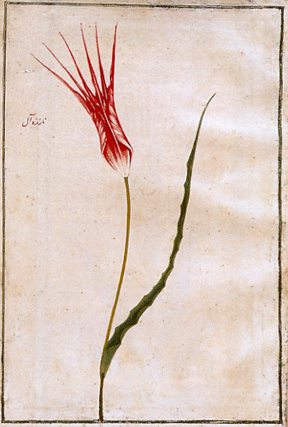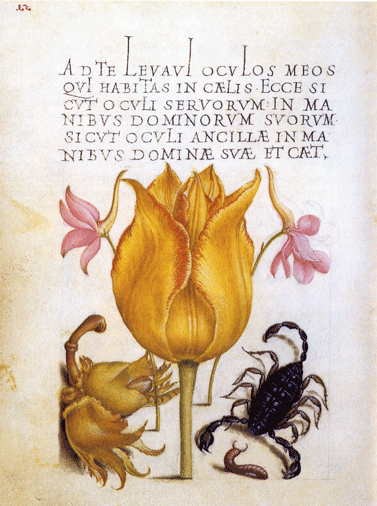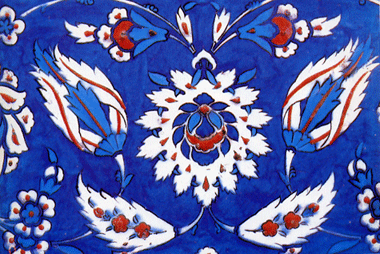
Nazende al (Flattering Red) from ‘The Book of Tulips’ ca 1725
by Anna Pavord
But as in any love affair, after the initial coup de foudre you want to learn more about the object of your passion. The tulip does not disappoint. Its background is full of more mysteries, dramas, dilemmas, disasters and triumphs than any besotted aficionado could reasonably expected. In the wild, it is an Eastern flower, growing along a corridor which stretches either side of the line of latitude 40 degrees north. The line extends from Ankara in Turkey eastwards through Jerevan and Baku to Turkmenistan, then on past Bukhara, Samarkand and Tashkent to the mountains of the Pamir-Alai, which, with neighbouring Tien Shan is the hotbed of the tulip family.
As far as western Europe is concerned, the tulip’s story began in Turkey, from where in the mid-sixteenth century, European travellers brought back news of the brilliant and until then unknown lils rouges, so prized by the Turks. In fact they were not lilies at all but tulips. In April 1559, the Zürich physician and botanist Conrad Gesner saw the tulip flowering for the first time in the splendid garden made by Johannis Heinrich Herwart of Augsburg, Bavaria. He described its gleaming red petals and its sensuous scent in a book published two years later, the first known report of the flower growing in western Europe. The tulip, wrote Gesner, had ‘sprung from a seed which had come from Constantinople or as others say from Cappadocia.’ From that flower and from its wild cousins, gathered over the next 300 years from the steppes of Siberia, from Afghanistan, Chitral, Beirut and the Marmaris peninsula, from Isfahan, the Crimea and the Caucasus, came the cultivars which have been grown in gardens ever since. More than 5,500 different tulips are listed in the International Register published regularly since 1929 by the Royal General Bulbgrowers’ Association of the Netherlands.
Holland was the setting for one of the strangest episodes in the long, mesmerising story of the tulip. The ‘Tulipmania’ that raged in Holland between 1634 and 1637 has puzzled historian s and economists ever since. How could it have ever happened that single bulbs of certain kinds of tulips could change hands for sums that would have secured a town house in the best quarter of Amsterdam? How was it possible that at the height of the tulip fever, a bulb of ‘Admiral van Enkhuijsen’ weighing 215 azen, could sell for 5,400 guilders, the equivalent of fifteen years’ wages for the average Amsterdam bricklayer? …

Tulip and Larkspur, by Joris Hoefnagel, ca 1590
The tulip flourished spectacularly in the later Ottoman empire, appearing as a motif on tiles, textiles, illuminated manuscripts, miniatures, headstones, prayer rugs and murals. But it does not appear at all on artefacts of the earlier Byzantine era. This is more likely to be because they did not value the tulip than because they were unfamiliar with it, although the anonymous writer of the Defter-i Lalezar-i Istanbul, the ‘Book of Tulip Gardens in Instanbul,’ does say that before the Seljuk invasion of Baghdad in 1055 only one kind of tulip, the Sahra-i Lale, or meadow tulip, was known in Istanbul. They were certainly known to the Seljuks who from the eleventh century onwards migrated west from their tribal lands in Central and Northeast Asia through Iran, Mesopotamia, and Syria. In 1096, they captured Konya in Inner Anatolia and tiles decorated with tulips, made by Anatolian Seljuks, have been excavated from the Palace of Alaeddin Keykubad I on the shores of Lake Beyshehir.

Stylized tulips and penoies underglazed Iznik tile, the second half of the sixteenth century, Tomb of Hurrem Sultan, Istanbul
In the relatively settled period following the Ottoman conquest of Constantinople, tulips flourished in the gardens laid out by Sultan Mehmet II (1451-1481), who remade great tracts of the city. He built himself a palace, the Topkapi Saray, on one of Constantinople’s seven hills, and laid out pleasure gardens inside the city’s courtyards. Surplus flowers from the Sultan’s twelve gardens were regularly sold in the flower markets and eventually a staff of 920 gardeners was needed to maintain his orchards, kitchen gardens and vast pleasure grounds. In his Treatise on Husbandry, Qasim ibn Yuruf Abu Nasri Haravi gave precise instructions for laying out such gardens. Water channels and pavilions, he wrote, should be enclosed within lines of poplars. For each bed in the pleasure garden, Qasim suggested different flowers: colchicums with violets, roses with narcissus and saffron crocus, Persian lilac with tulips and mauve stocks. The beds nearest the house were often filled with roses, sacred in Islam as the flower which sprang from Muhammad’s sweat.
In this culture, only particular flowers were valued: hyacinths, roses, jonquils, irises, carnations, and of course, tulips. Derived from the Persian, the Turkish word for tulip – lale – was written with the same Arabic letters as were used for the name of Allah, so the flower was often used as a religious symbol. Carved as a decorative device on buildings or fountains, it was the immediately recognisable emblem of the ruling House of Osman.
Excerpts from Anna Pavord, The Tulip: The Story of a Flower that Has Made Men Mad. New York: Bloomsbury, 1999, pp. 4, 6, 31, 33.